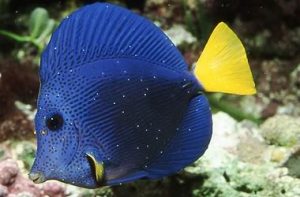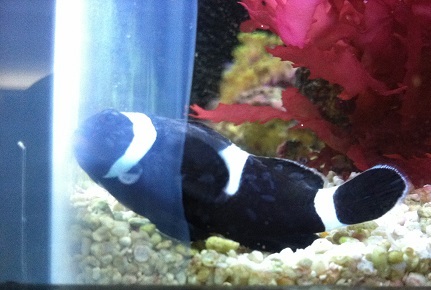- Joined
- Nov 9, 2014
- Messages
- 22,424
- Reaction score
- 34,850
Preface - Freshwater (FW) black mollies have been used for years in saltwater aquariums for algae control. However, this article will focus on their potential for identifying marine fish diseases present in a display tank (DT) and also quarantine tank (QT). The most important detail is to ensure you are using Freshwater black mollies for this purpose. Two reasons:
Acclimation - A slow (6-8 hours) drip acclimation period is best. Remember to temperature control the water, add an air stone to provide oxygen, and use an ammonia reducer (e.g. Prime, Amquel) if you suspect ammonia is starting to build up.
Any (freshwater) diseases the mollies were carrying will be eradicated once they are in full saltwater. So, no need to QT them. They are primarily herbivores, prefer low flow and have other requirements explained here: Keeping, Breeding, and Raising Saltwater Mollies
Testing a Fallow DT - The only reliable way to eliminate a disease from a reef tank is to starve it out by going fallow: https://www.reef2reef.com/threads/fallow-periods-going-fishless.190324/
You can test to see if a fallow period has been successful by using 2-3 black mollies, before introducing your QTd fish back into the aquarium. I advise a 2 week test period before giving the all-clear. You can house the mollies in an acclimation box or low flow area of your sump; or let them swim freely in your DT (they are easy to catch.) If evidence of disease presents itself on any one of the mollies, they all need to be removed, treated and the fallow period restarts. Furthermore, these same mollies are no longer suitable for testing marine diseases in the future. They are now SW fish who have encountered (and thus started to build up immunity to) a marine disease.
Furthermore, these same mollies are no longer suitable for testing marine diseases in the future. They are now SW fish who have encountered (and thus started to build up immunity to) a marine disease.
FYI; there's no reason why the above cannot also be used to test any DT or QT for active diseases.
QT Usage - Certain fish (notably wrasses) are notoriously sensitive to medications such as copper and Prazipro. This can make it difficult to prophylactically treat them for ich, velvet, flukes, etc. Compounding the problem is wrasses, clownfish, dragonets and other species have a thick mucous coat which often hides visible physical evidence (i.e. white dots) of parasites. What to do? Black mollies to the rescue! ;Smuggrin
Black mollies to the rescue! ;Smuggrin
By QTing black mollies alongside, this allows you to use them as "canary fish" to detect the presence of disease even if none of the other fish in QT are showing symptoms. This can be done via observation in a medication-free environment. However, I stress the following:
However, I stress the following:
 However, using FW black mollies to test for SW diseases is an accepted practice by Marine Biologists and public aquarium curators. And I feel the science is solid to extend this practice to also include active QT situations, for those hobbyists who prefer to just observe and/or less inclined to use meds as a prophylaxis. At the end of the day, the objective of QT is to introduce disease-free fish into the DT by any means possible.
However, using FW black mollies to test for SW diseases is an accepted practice by Marine Biologists and public aquarium curators. And I feel the science is solid to extend this practice to also include active QT situations, for those hobbyists who prefer to just observe and/or less inclined to use meds as a prophylaxis. At the end of the day, the objective of QT is to introduce disease-free fish into the DT by any means possible.
However, I stress that once you buy FW black mollies you have a moral obligation to care for them the same as any other fish. They are not "throwaway fish" to be discarded after they have served a purpose. :mad: Mollies are "reef safe" algae eaters and adapt well to a reef environment. Or they can be housed in a quiet sump area (e.g. refugium) or as semi-permanent QT inhabitants (until a disease pops up.) You also have the option of converting them back to full freshwater. However, I urge you to care for them yourself, or rehome them to someone with a dedicated FW tank. Sending them back to a LFS leaves open the possibility that another reefer may purchase them for the same reason, and those mollies might fail to test positive for a disease which they have already been exposed to. ;Doctor
- Evidence of ectoparasites (e.g. ich, velvet, brook) will show as white spots on a fish or translucent for flukes (examples below). This makes them easier to see on a black colored fish.
- A freshwater black molly will have no immunity whatsoever to marine diseases, thus making it probable for visible symptoms to show. However, a molly which has been kept in saltwater (SW) will begin building up immunity to whatever diseases it has been exposed to, the same as any other SW fish.
ICH
 FLUKES
FLUKES



Acclimation - A slow (6-8 hours) drip acclimation period is best. Remember to temperature control the water, add an air stone to provide oxygen, and use an ammonia reducer (e.g. Prime, Amquel) if you suspect ammonia is starting to build up.
Any (freshwater) diseases the mollies were carrying will be eradicated once they are in full saltwater. So, no need to QT them. They are primarily herbivores, prefer low flow and have other requirements explained here: Keeping, Breeding, and Raising Saltwater Mollies
Testing a Fallow DT - The only reliable way to eliminate a disease from a reef tank is to starve it out by going fallow: https://www.reef2reef.com/threads/fallow-periods-going-fishless.190324/
You can test to see if a fallow period has been successful by using 2-3 black mollies, before introducing your QTd fish back into the aquarium. I advise a 2 week test period before giving the all-clear. You can house the mollies in an acclimation box or low flow area of your sump; or let them swim freely in your DT (they are easy to catch.) If evidence of disease presents itself on any one of the mollies, they all need to be removed, treated and the fallow period restarts.
FYI; there's no reason why the above cannot also be used to test any DT or QT for active diseases.
QT Usage - Certain fish (notably wrasses) are notoriously sensitive to medications such as copper and Prazipro. This can make it difficult to prophylactically treat them for ich, velvet, flukes, etc. Compounding the problem is wrasses, clownfish, dragonets and other species have a thick mucous coat which often hides visible physical evidence (i.e. white dots) of parasites. What to do?
By QTing black mollies alongside, this allows you to use them as "canary fish" to detect the presence of disease even if none of the other fish in QT are showing symptoms. This can be done via observation in a medication-free environment.
- The observation period does not start until mollies are added to the QT. This should happen ASA (or even just before) fish are added. Because you are having to wait for any parasites to drop off, encyst and then release free swimmers to infect the mollies; observation time should be 4-6 weeks.
- Be aware that not all SW fish are suitable tank mates for mollies. They are easily bullied or even eaten by large aggressive species (e.g. triggers, groupers, eels). So, the mollies may need to be QTd in an acclimation box or with a tank divider.
- Watch the mollies (and all the other fish) for symptoms of disease every single day. So, this is not a reliable method for those with busy schedules, or who will have to leave the QT unobserved due to work/vacation trips. Watch for visible physical symptoms to manifest (e.g. white dots/splotches), and also behavioral symptoms of disease. Heavy breathing, lack of appetite, scratching, lethargy, head twitching, swimming into the flow of a powerhead are all things which can forewarn you that trouble is on the way. ;Wideyed
- Once symptoms of disease have been observed/detected, all fish in the QT must be treated ASAP. This includes the mollies! And again, any mollies who have encountered a SW disease must no longer be considered viable for testing marine diseases in the future.
- This method is less reliable for detecting flukes, since those often infect the gills and are more difficult to see when they crawl over the scales. (And they would crawl pretty fast over a small molly.) Still, a molly can be checked for flukes at any time via a FW dip - so as not to subject a more delicate specimen to the same test.
And any dead molly should be given a FW dip to check for flukes (tap is fine when the fish is deceased.)
However, I stress that once you buy FW black mollies you have a moral obligation to care for them the same as any other fish. They are not "throwaway fish" to be discarded after they have served a purpose. :mad: Mollies are "reef safe" algae eaters and adapt well to a reef environment. Or they can be housed in a quiet sump area (e.g. refugium) or as semi-permanent QT inhabitants (until a disease pops up.) You also have the option of converting them back to full freshwater. However, I urge you to care for them yourself, or rehome them to someone with a dedicated FW tank. Sending them back to a LFS leaves open the possibility that another reefer may purchase them for the same reason, and those mollies might fail to test positive for a disease which they have already been exposed to. ;Doctor



















